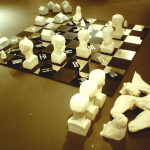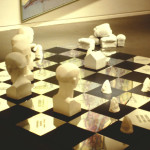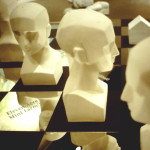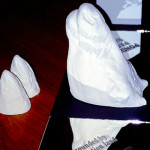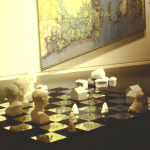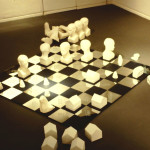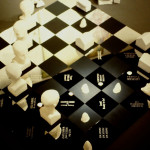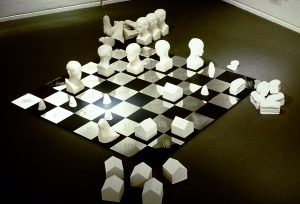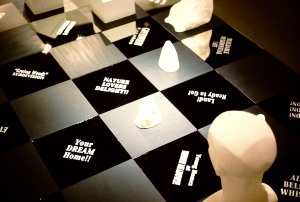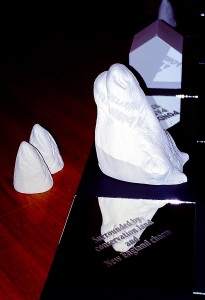In Trespass, a collaboration with John Noelke, life-size plaster game pieces compete for space on a chess board of nature-centric real estate slogans.
“…[Trespass] enacts the environmental stewardship themes ongoing in McQuillen’s work. Together, McQuillen and Noelke create a work which delves beyond the most basic definition of ‘trespass’ as ‘to pass beyond or cross.’ Over time, the term has developed legal, religious, and metaphysical connotations. To these artists, ‘trespass’ speaks to movement and interaction, connection and loss. In this confrontational mixed-media work they pose the question, “Who are the trespassers and who are the trespassed?’”
– Tolnick, Judith. The Visual Arts Program of Sea Grant Rhode Island: The First Ten Years.
Show Program. University of Rhode Island, RI. July, 1998.
“The real estate ‘game’ becomes exactly that in the ambitious installation Trespass, where Charles McQuillen, in collaboration with John Noelke, has fabricated a giant chessboard with life-size plaster casts of sportsmen’s trophies—an elk’s head, a large trout—as well as a man, looming largest, for pieces. The squares, made of mirror to further underscore the narcissism, are inscribed with classified ads promising the sublime: ‘Sanctuary!’ ‘Nature Lover’s Delight!’ ‘Lakefront Jewel New to Market!’…”
– Markham, Pamela. “The Visual Arts Program of Sea Grant, Rhode Island: The First Ten Years,”
Art New England (vol 19, number 6). October/November 1998.
In this installation John Noelke and I explore the abstract notion of trespass, an interesting concept to explore for a first collaboration. Since we lived hundreds of mile apart, we added to the challenge of our first collaboration by conceiving and fabricating the entire piece over the phone. We spent long hours brainstorming ideas and talking through the entire art making process. Like any true collaboration, we had to learn to not step on, or rather trespass on, each other’s ideas, while at the same time, holding our own ground. I tell you, just through his shear persistence, Noelke could talk a hungry dog off a meat wagon.
We settled on the game concept quickly. A game’s overarching desire to win control of finite assets and the strategic give and take within a game seemed fitting. It took longer to let go of a rocking table/board that tilted with the imbalance of the game. After exploring several technical, albeit clunky, solutions, we gave up on this idea for the sake of simplicity and clarity. We however, follow through with the desire to slightly lift the game board off the floor.
The game board and pieces grew out of our individual expertise. For the game piece we knew we wanted to evoke the competing interests and players who vie for space, so we settled on a few distinct representations. John has considerable experience with mold making and plaster casts, so he fabricated the more complicated elk heads (taxidermy form), human heads (sculpture form), and fish heads (actual fish he caught). I fabricated the loaves of bread (actual) and house pieces. The use of plaster provided an important consistency between the pieces, even though they were fabricated in different studios. I had been experimenting with the expressive potential of mirrors and ways to etch images and words onto them. Simply flipping over every other mirror gave us the checkerboard pattern. The nature-centric real estate slogans were collected from local developments and advertising.
While you can try to predict how the parts of an installation will interact, there is nothing like the experience of pulling all the pieces together. For example, you know that with proper lighting, mirror surfaces can reflect outside images and project surface detail. It was only upon assembling this piece that we fully realized this expressive potential. The white plaster pieces proved ideal backdrops for the projected real estate slogans that further encroached on their limited space. At the same time, the viewer becomes implicated in the game as their own images fill the mirrored squares, mixing with the reflections of the game pieces and the etched real estate slogans. These added layers and the way they interacted created a nice depth to the piece. I love how the arts can make the abstract felt.
Trespass offers a lot of room for interpretation and discussion.
- As a class, have students take a look at this installation from its multiple angles. Have them identify the installation’s various elements. List out on an anchor chart everything they identify. What they see matters, so don’t be quick to correct some who might say “horse head” instead of “elk head.”
- Then, in small groups, have them discuss how they interpret this installation. Have them identify the visual clues that support their understanding. Note where they share interpretations and where they diverge.
- Reconvene as a class. Have each small group report out their findings. On the anchor chart, identify both shared and individual interpretations. Bring the art critics into this group discussion by reading their reviews aloud.
- Now bring the artists’ views into the discussion by reading aloud Upon Further Reflection. Ask students how their understanding and appreciation for the piece has changed as the conversation grew. Also, ask what they think the artist meant when he said, “I love how the arts can make the abstract felt.”
Using art to make the abstract felt
Ecosystems can be especially complex, dynamic, and abstract. Artists such as Yutaka Kobayashi, Anke Mellin, Shelley Sacks, Kim Stringfellow, and Othello Anderson and Bonnie Ora Sherk explore ecosystems as a means for personal reflection, community dialogue, and transformation. Have students consider how these artists use art to build understanding, unpack complex issues and make the abstract felt.

